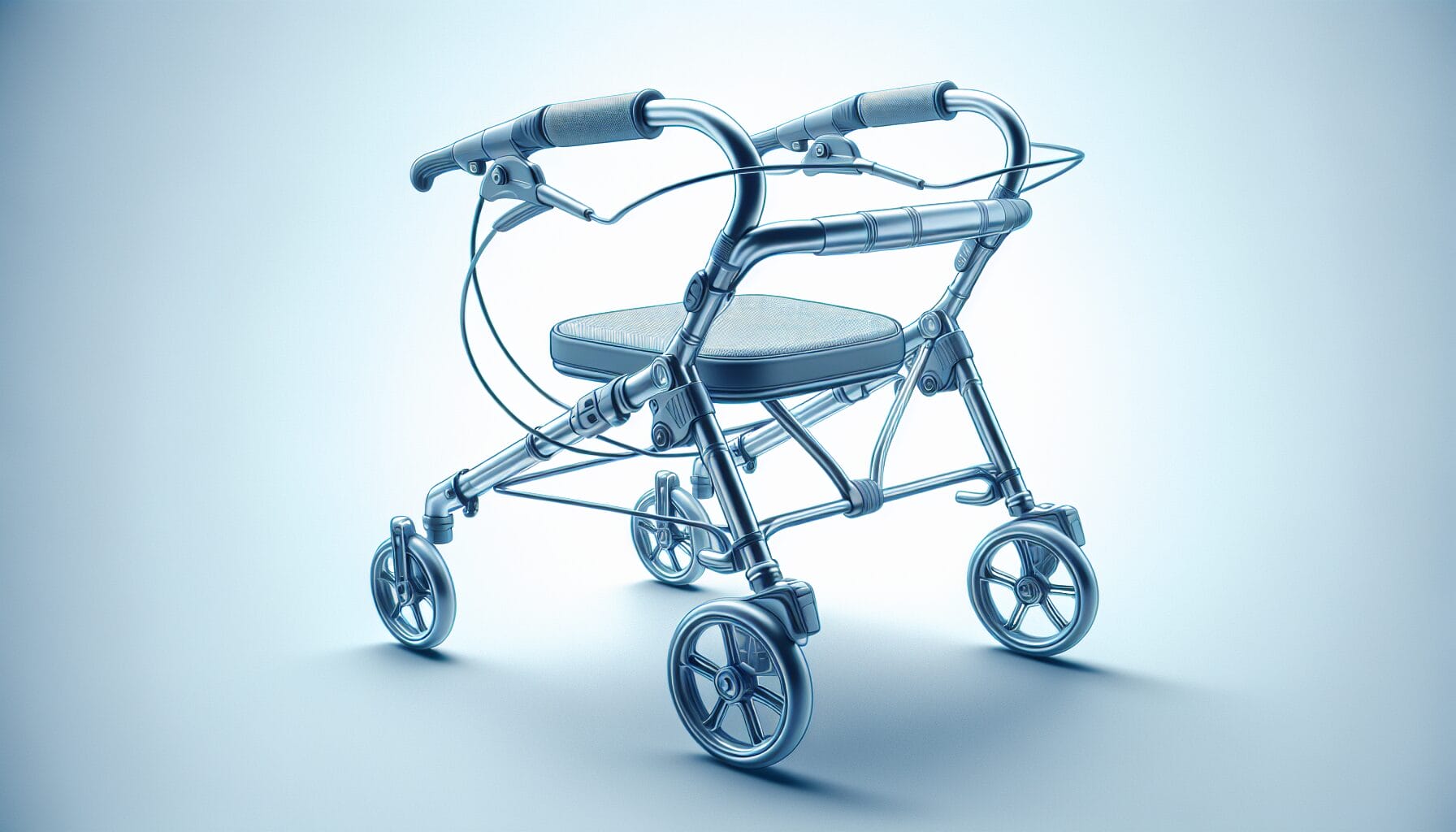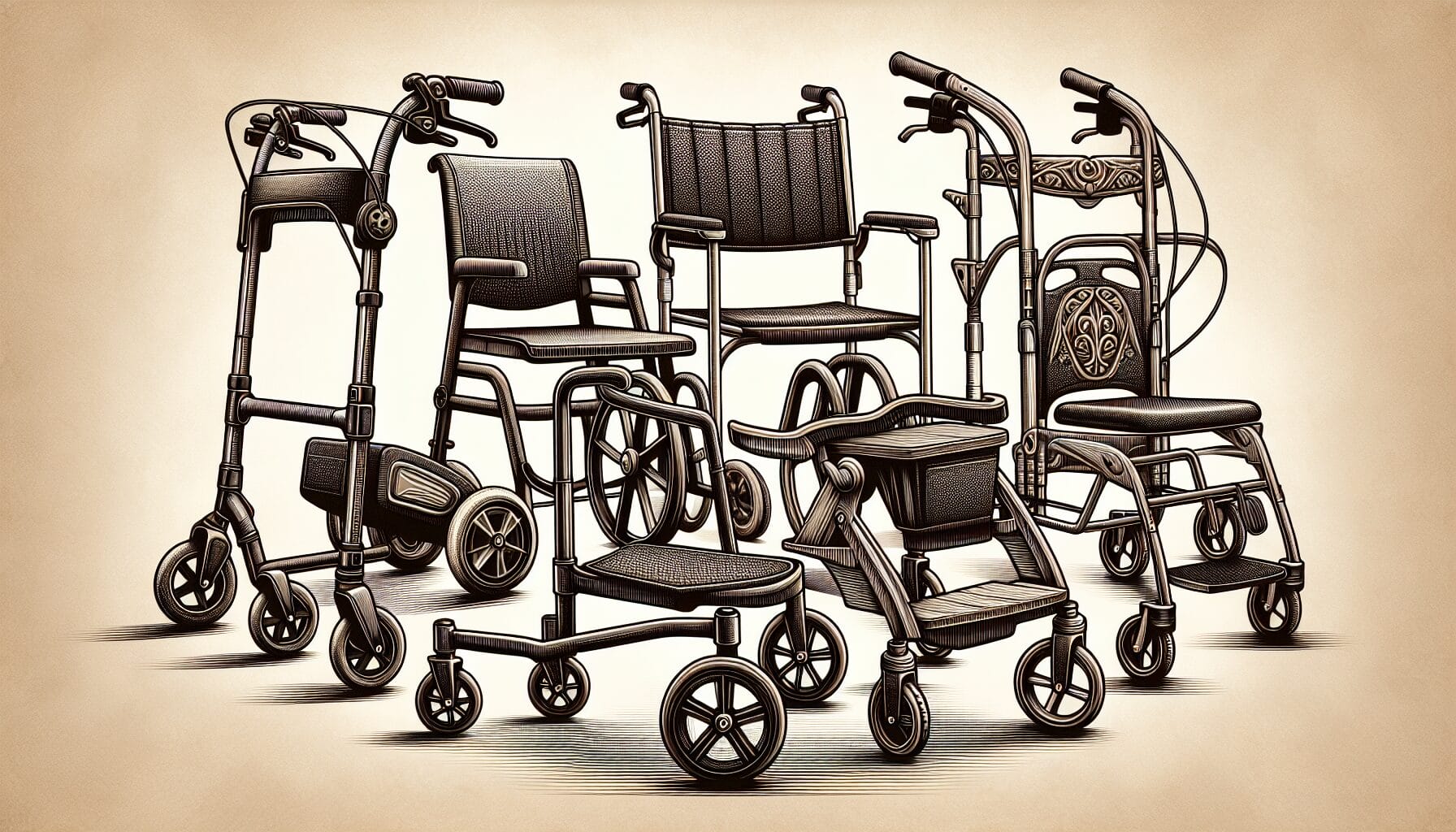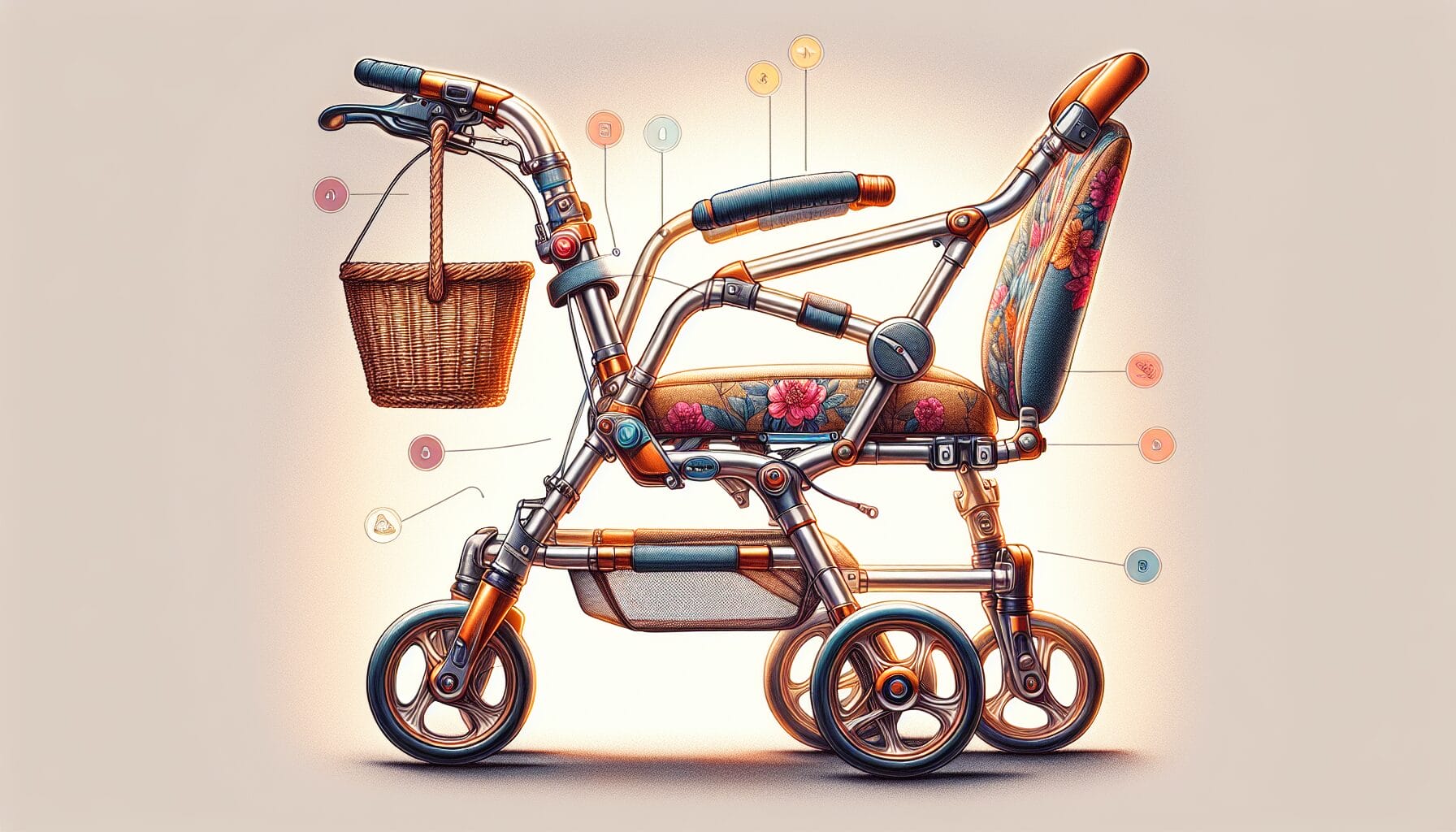What is a rollator? Simply put, it’s a walker with wheels, brakes, and a seat designed to support those with walking impairments. In this piece, we will explore the elements that make rollators an invaluable aid, their various types, and their impact on daily life without overwhelming you with jargon or aggressive sales pitches.
Summary Preview
A rollator is a wheeled walker designed for stable mobility, featuring a sturdy frame, user-friendly handlebars, a built-in seat, and convenient storage options, catering to the needs of those with walking difficulties.
Various types of rollators exist, each with different features like adjustable handlebars, brakes, and wheel sizes to match the user’s preferences and lifestyle, ensuring enhanced mobility both indoors and outdoors.
Rollators can improve walking performance and musculoskeletal health, involve key considerations for the right fit, such as height and weight capacity, and may be covered under Medicare or Medicaid to aid affordability.
Defining a Rollator

Have you ever wondered what sets a rollator apart from other mobility aids? A rollator, often known as a rolling walker, is a type of wheeled walker designed to provide support and stability for those who have difficulty walking. Unlike traditional wheeled walkers and standard walkers, rollators are equipped with wheels on all legs, allowing for smooth movement without the need to lift the device. They are ideal for individuals seeking a combination of stability and maneuverability, enabling them to cover longer distances with comfort and ease. Conversely, standard walkers usually include wheels on the front two legs, with no wheels on the back two legs of traditional walkers.
The hallmark of a rollator is its thoughtful design, which typically includes:
A sturdy frame
User-friendly handlebars
A built-in seat for resting
Convenient storage options
These features collectively contribute to the rollator’s ability to foster enhanced mobility, walking speed, and independence. Whether you’re moving around the house or taking on outdoor adventures, a rollator can be your reliable companion, helping you navigate the world with confidence.
Frame and Construction
The backbone of any rollator is its frame, which must be both lightweight for easy maneuverability and sturdy enough to support the user’s weight. Typically constructed from materials like aluminum, rollator frames offer a stable base without adding unnecessary bulk, making them simpler to push and turn. However, for those requiring a bit more support, steel frames are also available, providing additional strength for users over 250 pounds.
It’s the choice of material that ensures the rollator’s durability and stability, two indispensable qualities for a reliable walking aid. A rollator with a well-constructed frame offers a steadfast support system, allowing users to walk with confidence, knowing their aid won’t let them down.
Wheels and Maneuverability
Imagine smoothly gliding over sidewalks, carpets, and even grass with ease. That’s the kind of freedom rollator wheels offer. Designed to enhance mobility, these wheels come in various types and sizes to meet the needs of different surfaces and environments, including motorized wheelchair users. Larger, rotating wheels are particularly adept at handling rough terrain, not only improving mobility but also reducing the effort required by the user.
For those with a more adventurous spirit or who live in areas with uneven outdoor terrain, pneumatic tires on rollators are a game-changer. These tires offer better suspension that traditional mobility aids, providing a smoother experience and less rolling resistance, which is a significant advantage for individuals with sensitivity in their hands or joints. The right wheels make all the difference, enabling users to turn a challenging walk into a comfortable journey.
Handlebars and Brakes
Ergonomics plays a central role in the design of rollator handlebars. Some key features include:
Height adjustability to cater to the comfort of the user
Padding or textured surfaces to prevent hand fatigue during long walks
Thoughtful design to ensure users can maintain a natural posture and grip comfortably, reducing the risk of strain.
But what about when you need to pause or navigate a slope? That’s where the hand brakes come in. Rollators feature easy-to-apply hand brakes that allow users to control their pace and stop safely, adding an essential layer of safety. Especially outdoors, these brakes are an indispensable added safety feature, offering the control needed to handle slopes and uneven terrain confidently on four wheels.
Seat and Storage Options
One of the most appreciated features of many rollators is the built-in seat, offering a stable support on four wheels for users to rest whenever needed. These seats are typically designed with a padded seat, ensuring that users can sit comfortably during breaks in their activity. The ability to fold the seat away when not in use adds to the rollator’s versatility, making it suitable for different scenarios and needs.
Alongside the comfort of a seat, storage options like baskets and pouches provide the practicality of carrying personal belongings. This feature is particularly useful as it frees up the hands to focus on steering and braking, enhancing the independence rollators are known to provide. With a place to rest and a way to carry essentials, rollators truly cater to the on-the-go lifestyle of their users.
Types of Rollators and Their Features

Rollators come in a variety of shapes and sizes, each designed with specific features to match the user’s lifestyle and preferences. For those who prioritize lightness and agility, a three wheel rollator is a solid choice, featuring greater maneuverability. However, they typically come without a seat, trading off stability for a more compact design.
Four-wheeled rollators, on the other hand, offer improved stability and often include a seat for resting, making them a go-to for users who need additional balance support. Heavy-duty rollators are built to withstand higher weight capacities, providing a robust option for larger individuals. And for those who face varied terrain, rollators with larger wheels are designed to navigate outdoor spaces with ease.
Foldable models are also available, offering convenience for storage and transportation. With so many options, it’s clear that there’s a rollator out there to meet the needs and enhance the mobility of virtually any user.
Enhancing Mobility with Rollators
Rollators don’t just offer support; they transform the way users walk. Studies have shown that using a rollator can improve walking performance, increasing distance, cadence, and velocity. This isn’t just about moving from point A to point B; it’s about doing so with greater ease and less strain on the body, supporting an active and independent lifestyle that many cherish.
The biomechanical benefits of rollators are significant. They have been shown to:
Reduce the load on the knee extensors and shift some of that load to the hip extensors, easing overall strain on joints and muscles
Positively impact balance and functionality
Serve as a valuable tool in rehabilitation programs and in maintaining musculoskeletal health, especially when the alternative might be complete immobilization.
Rollator vs. Walker: Choosing the Right Mobility Aid
When deciding between a rollator and a traditional walker, it’s crucial to consider the specific needs and abilities of the user. Rollators, with their wheeled legs and sophisticated features like adjustable height and hand brakes, allow for a faster pace and a more normal gait. They are suited for individuals who can walk but need assistance with balance and stability.
Walkers, on the other hand, offer significant stable support and are ideal for individuals with lower body weakness or severe balance issues, particularly those recovering from surgeries like hip or knee replacements. While rollators cater to a more mobile user, walkers provide the firm support needed for those with more significant mobility issues.
Though rollators tend to be more expensive, the added mobility, convenience, and features they provide can be well worth the investment for many users. This in-depth study from the National Institute of Health shows how effective a rollator can be in assisting your loved one with balance and mobility.
Rollator Accessories and Customization

The personalization of rollators extends beyond selecting the right model. Accessories can greatly enhance comfort and functionality, turning a standard rollator into one that’s perfectly tailored to an individual’s needs. Soft seat cushions can transform a brief rest into a rejuvenating pause, and comfortable grips can make the difference between a pleasant stroll and a painful experience.
When it comes to convenience, customization options like expandable door hinges, walker trays, and cup holders can make using a rollator a breeze. A Vive Cup Holder, for instance, allows users to have their favorite beverage at hand without juggling cups and handles. And storage baskets provide the perfect spot for shopping bags or personal items, ensuring that everything the user needs is within easy reach.
Rollator Safety and Maintenance Tips
Ensuring the safety of rollator use is paramount, and it starts with basic maintenance and awareness. For instance, engaging the parking brake before sitting on the rollator’s seat is a simple yet critical action to prevent accidents. Likewise, regular inspections of the wheels and tips for wear and debris can help maintain stability and prevent falls. This is one of the many services that a senior in-home caregiver can assist with.
Maintenance is not just about safety but also about extending the life of the rollator. Cleaning the device, tightening screws, and replacing worn components are all part of a routine that keeps the rollator in top condition. And remember, making unauthorized modifications or using non-original accessories can void the warranty and pose safety risks, so always consult a dealer or the manufacturer before making changes.
How to Choose the Best Rollator for Your Needs
Selecting the best height adjustable rollator is a personal decision that should take into account several key factors, including the user’s body weight. Here are some important considerations:
Handle height: The handle height should match the user’s natural arm length to maintain proper posture.
Seat height: The seat height must allow the feet to touch the ground comfortably when seated.
Weight capacity: Weight capacity is another important consideration. Standard rollators typically support up to 250 pounds, with bariatric models going up to 500 pounds.
Preferences extend to other features as well, such as the desire for a lightweight model for easy transport or the need for adjustable height settings for changing abilities over time. It’s also wise to assess customer reviews, return policies, and product warranties to ensure a secure investment in the chosen mobility aid.
Rollator Use in Different Environments
A rollator can be a trusty companion in a variety of settings, but it’s important to consider its suitability for different environments. Indoor use typically calls for smaller wheels for smoother navigation, while outdoor adventures benefit from larger wheels to tackle uneven terrain.
The overall width of a rollator is another key consideration, as it determines whether the device can fit through narrow doorways and tight passageways without issue.
Financial Assistance and Insurance Coverage for Rollators
The cost of a rollator can be a concern for many, but financial assistance and insurance coverage might be available to help. Medicaid and Medicare classify walkers and rollators as durable medical equipment, which means they may cover a portion of the costs. For Medicare Part B to cover a rollator, it must be prescribed by a Medicare-approved physician as medically necessary, which must be documented.
After meeting their annual deductible, Medicare beneficiaries typically pay 20% of the Medicare-approved amount for a rollator. This can make the device more accessible for those who need it but might otherwise be deterred by the price. It’s worth exploring these options to ensure support is available when mobility is a necessity.
In this journey through the world of rollators, we’ve uncovered the vast possibilities these mobility aids offer. From their ergonomic design to the various types available, and from safety considerations to insurance coverage, rollators represent a beacon of hope for individuals seeking to maintain their independence and mobility. May the knowledge shared here inspire you to explore the options and find a rollator that supports your active lifestyle and allows you to move through life with confidence and ease.
Frequently Asked Questions
Do rollators have seats?
Yes, most rollators have a built-in seat for convenience when you need to sit down.
What is the purpose of a rollator?
The purpose of a rollator is to increase mobility and comfort for individuals experiencing a range of physical afflictions, such as arthritis, back pain, sciatica, muscle weakness, and balance issues. It can be beneficial for people of all ages.
Who should not use a rollator walker?
If you have issues with balance, weakness while standing, or need a firm, immobile support to help you walk, you should not use a rollator walker. It’s best to use a walker instead.
What is the difference between a rolling walker and a rollator?
The main difference is that rollators have wheels on all legs, while walkers either have no wheels or only on the front two legs. This provides more mobility and stability for users.
Can rollators be used both indoors and outdoors?
Yes, rollators can be used both indoors and outdoors, just make sure to choose the right wheel size and width for smooth maneuverability.